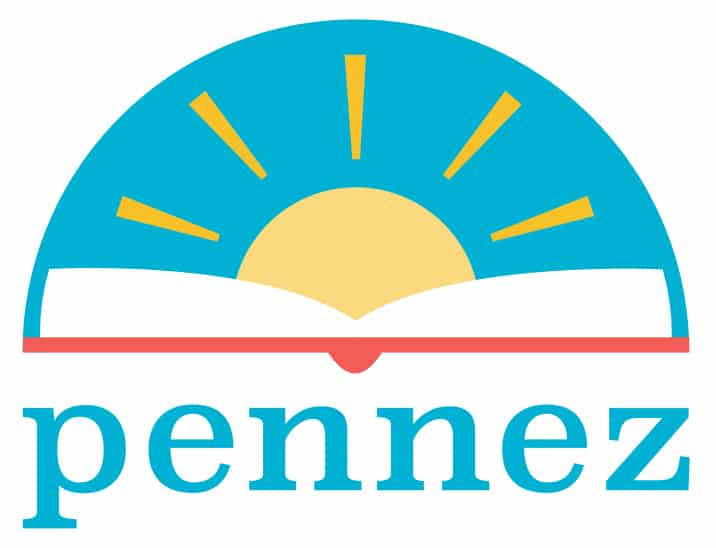-
Booklist: Books about the Juneteenth holiday and what it means for African American communities.
-
Juneteenth is a holiday to celebrate the end of enslavement. After enslavement was Reconstruction. After and during Reconstruction the Black Codes were established. A short history from Stony the Road.
Juneteenth is celebrated on June 19th each year in African American communities to celebrate when the Union army announced the freedom of slaves in 1865 in Galveston, Texas. However, two years before this announcement, Abraham Lincoln issued the Emancipation Proclamation in 1863 during the Civil War. This Proclamation gave slaves the freedom of enslavement. Still, other challenges arose from slaves becoming free. For example, the ideologies of white supremacy remained where Black Codes and then the Jim Crow Laws were established.
After the Civil War ended, Reconstruction took place to bring the Confederate states back into the Union while also giving African Americans freedom, citizenship, political rights, civil rights, and economic rights. In many ways, Reconstruction did not give Blacks the rights they expected. Other scholars say that it failed. 1
Despite the challenges from former slaveholders and society, African Americans continue to celebrate how far they have come and Juneteenth is one example. Below are Juneteenth books for children in grades Pre-K through 5th.
1. Juneteenth by RJ Bailey
A story for pre-K through kindergarten readers. Describes what this holiday means and what people do such as parades food and gatherings.
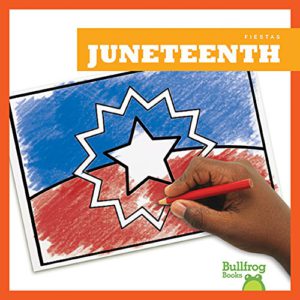
2. Juneteenth by Vaunda Micheaux Nelson and Drew Wilson
A detailed story for K-2 readers. This story describes how the last news was shared about the end of slavery in Galveston Texas. Even though the news was shared in 1865, during the Civil War Abraham Lincoln signed the Emancipation Proclamation in 1863. In the end, this
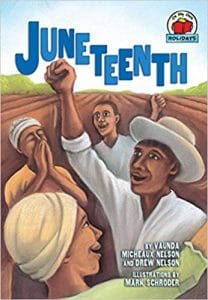
3. Juneteenth for Mazie by Floyd Cooper
Mazie’s father tells her how her grandfather was a former slave and heard the news in Galveston Texas. He then told her how black people struggled after they were freed but kept working for equal rights. He encourages his daughter to celebrate and to remember.

4. Let’s Celebrate Emancipation Day and Juneteenth by Barbara deRubertis
A nonfiction book for elementary readers discussing the reasons why Juneteenth even started which was due to the end of slavery. The author shares facts about pivotal abolitionists-such as Frederick Douglass. Later the author shares what life was like after the proclamation was given. Even though slavery is a dark part of our history Juneteenth celebrates freedom and about our ancestors as this book shares at the end.

5. All Different Now By Angela Johnson Illustrated by EB Lewis
A story about a small enslaved child who witnessed her family becoming free. The illustrations captivate the narrative’s emotions. The writer writes in a poetic form to demonstrate the tremendous hope and joy that oppressed people heard about being free from enslavement.
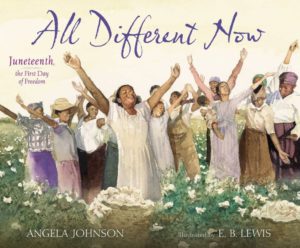
6. Freedom’s Gifts By Valerie Wesley
A Juneteenth Story
June lives in Texas in 1943. African American people living in the South were legally segregated from the white community. This year and June was going to celebrate Juneteenth with her family and her cousin Lillie who lived in the North. June enjoyed where she lived, but Lillie always complained. June didn’t say anything. Through the story, we learn about her Aunt Marshall who witnessed slavery. She didn’t enjoy discussing it but loved Juneteenth. This story brings generational experiences and historical experiences about what it means to be Black and free.
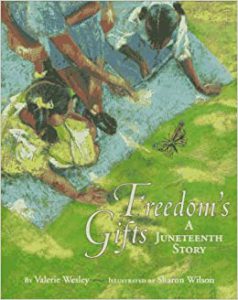
7. Come Juneteenth by Ann Rinaldi
A historical fiction novel for Elementary-aged readers. Luli lives in Texas but is raised by her Master’s family. She enjoys her family and is afraid of change. Once she discovers that slaves are free, she does not tell. Two years later, soldiers come to Texas and her world is changed forever.
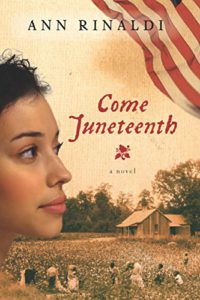
8. The Story of Juneteenth An Interactive History Adventure
By Steven Otfinoski
This reader for elementary-aged readers allows the reader to choose a different story paths and endings. The reader decides to follow the story of a teenage girl, or a black man. Some endings have joy, others endings are faced due to racism. Not only does one learn about Juneteenth, but they learn what happens to African Americans once they are freed from slavery.
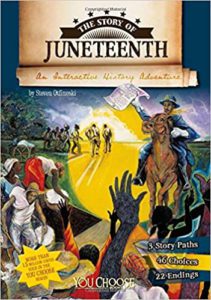
More details from Stony the Road provides dates and explanations on what happened after Black Americans were freed from enslavement.
- 1865-1877 is the Reconstruction era in the United States. Reconstruction ended in 1877, because of the 1877 Compromise. This Compromise gave Confederate Democratic states electoral votes in exchange for a withdraw of federal troops in the South.
- 1865 Mississippi and South Carolina were some of the first states enacting the Black Codes which restricted Black people from specific freedoms. Eventually, former Confederate states adopted the Black Codes.
- Post Civil War, the 13th, 14th, and 15th Amendments were ratified to end slavery, give Black men the right to vote, and recognize an individual’s citizenship if born in the United States.
There was also a larger question in the North and South was what to do with the Negro. The Cincinnati Enquirer stated, “Slavery is dead,” but “The negro is not, there is the misfortune.” We all know this was too true.
Quasi-Slavery or Quasi-Freedom
Former slaves were either migrating to the North to look for better jobs, and some remained working for a wage with their former Plantation owners. Henry Louis Gates calls this period “quasi-freedom or quasi-slavery: a state of being trapped in nether zone, between a state of being and nothingness, painted as unworthy of citizenship rights granted prematurely by contemporaries eager to justify the implementation of neo-slavery.” 1
One area of importance is that the celebration of enslavement ended, the need for cotton increased from 1860-1890, and doubled in 1920. Cotton was considered “King” because it made plantation owners wealthy and grew their capital. Once slavery ended Blacks were converted into sharecroppers.
Sharecropping is defined as a category of farming where owners rented parts of their land to families. Whenever families grew a portion of their crops of part of their crops were given to the landowner. In essence, this became an economic deficit because families owed the landowners money if they were not able to produce the number of funds to cover their crops.
The sentiment of being freed was an event that altered the lives of millions of African Americans. 1 Frederick Douglass spoke, “At last, at last the black man has a future. Heretofore all was dark, mysterious, chaotic. We were chained to all the utterable horrors of never ending fixedness. Others might improve and make progress, but for us, there was nothing but the unending monotony of stagnation, for moral, mental and social death. Today we are free American citizens. We have ourselves, we have a country, and we have a future in common with other men.
More Booklists Here
1 Gates, H. L. (2019). Stony the Road. Penguin Press.
